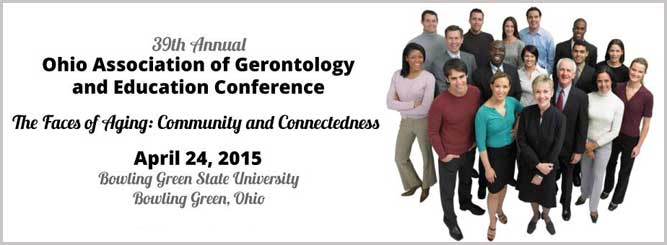Paper Session VIII - Service Learning
Location
BTSU 316
Start Date
24-4-2015 1:45 PM
End Date
24-4-2015 2:45 PM
Description
As technology progresses, older generations are being given ‘smart’ devices and are adopting these devices to keep up with daily life. Stereotypes posit that the different generational groups perspectives on each other and the digital divide prohibit older generations from adopting new technologies. At the Wood Country Center on Aging located in Bowling Green Ohio, the small group communication class of Bowling Green State University teaches tablet classes once a week to interested older adults. Classes were observed using the STAM (Senior Technology and Acceptance Model), specifically the acceptance phase, over six weeks with narrative and phenomenological research methods. Observing and assisting four small groups teaching older adults different categories of smart tablets, conclusions were made on why older adults accept the technology and even come back for further classes. At the end of the project, it was found that the more positive and genuinely encouraging the students were, the more the older adults consistently attended classes and engaged in learning. Despite rumors of barriers of an age and digital divide, social cues, the relationships made, and the environment play a part in the motivation of technological diffusion in older adult’s daily life.
Included in
Older Adults and Technology: Adoption and Acceptance Comes from Relationships and Encouragement from Younger Generations
BTSU 316
As technology progresses, older generations are being given ‘smart’ devices and are adopting these devices to keep up with daily life. Stereotypes posit that the different generational groups perspectives on each other and the digital divide prohibit older generations from adopting new technologies. At the Wood Country Center on Aging located in Bowling Green Ohio, the small group communication class of Bowling Green State University teaches tablet classes once a week to interested older adults. Classes were observed using the STAM (Senior Technology and Acceptance Model), specifically the acceptance phase, over six weeks with narrative and phenomenological research methods. Observing and assisting four small groups teaching older adults different categories of smart tablets, conclusions were made on why older adults accept the technology and even come back for further classes. At the end of the project, it was found that the more positive and genuinely encouraging the students were, the more the older adults consistently attended classes and engaged in learning. Despite rumors of barriers of an age and digital divide, social cues, the relationships made, and the environment play a part in the motivation of technological diffusion in older adult’s daily life.


